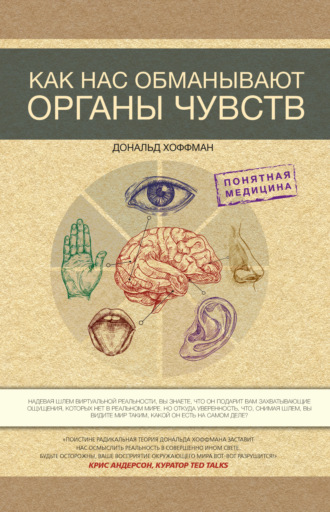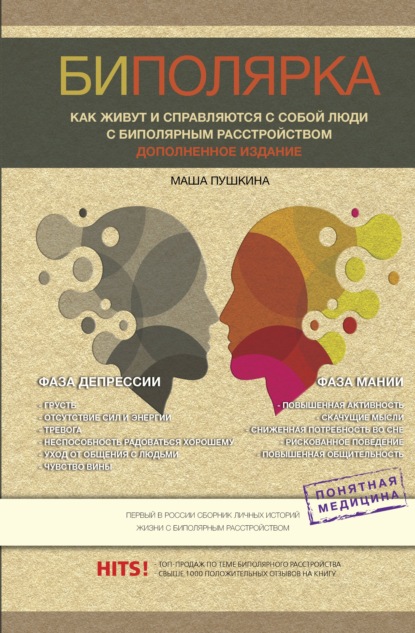
Полная версия
Как нас обманывают органы чувств
53
Smuts, B. B. 1995. “The evolutionary origins of patriarchy,” Human Nature 6: 1–32.
54
Buss, D. M. 1994. “The strategies of human mating,” American Scientist 82: 238–49; Gil-Burmann, C., Pelaez, F., and Sanchez, S. 2002. “Mate choice differences according to sex and age: An analysis of personal advertisements in Spanish newspapers,” Human Nature 13: 493–508; Khallad, Y. 2005. “Mate selection in Jordan: Effects of sex, socio-economic status, and culture,” Journal of Social and Personal Relationships, 22: 155–68; Todosijevic, B., Ljubinkovic, S., and Arancic, A. 2003. “Mate selection criteria: A trait desirability assessment study of sex differences in Serbia,” Evolutionary Psychology 1: 116–26; Moore, F. R., Cassidy, C., Smith, M. J. L., and Perrett, D. I. 2006. “The effects of female control of resources on sex-differentiated mate preferences,” Evolution and Human Behavior 27: 193–205; Lippa, R. A. 2009. “Sex differences in sex drive, sociosexuality, and height across 53 nations: Testing evolutionary and social structural theories,” Archives of Sexual Behavior 38: 631–51; Schmitt, D. P. 2012. “When the difference is in the details: A critique of Zentner and Mtura Stepping out of the caveman’s shadow: Nations’ gender gap predicts degree of sex differentiation in mate preferences,” Evolutionary Psychology 10: 720–26; Schmitt, D. P., Youn, G., Bond, B., Brooks, S., Frye, H., Johnson, S., Klesman, J., Peplinski, C., Sampias, J., Sherrill, M., and Stoka, C. 2009. “When will I feel love? The effects of culture, personality, and gender on the psychological tendency to love,” Journal of Research in Personality 43: 830–46.
55
Buss, D. M., and Schmitt, D. P. 1993. “Sexual strategies theory: An evolutionary perspective on human mating,” Psychological Review 100: 204–32; Brewer, G., and Riley, C. 2009. “Height, relationship satisfaction, jealousy, and mate retention,” Evolutionary Psychology 7: 477–89; Courtiol, A., Ramond, M., Godelle, B., and Ferdy, J. 2010. “Mate choice and human stature: Homogamy as a unified framework for understanding mate preferences,” Evolution 64(8): 2189–2203; Dunn, M. J., Brinton, S., and Clark, L. 2010. “Universal sex differences in online advertisers’ age preferences: Comparing data from 14 cultures and 2 religious groups,” Evolution and Human Behavior 31: 383–93; Ellis, B. J. 1992. “The evolution of sexual attraction: Evaluative mechanisms in women,” in J. Barkow, L. Cosmides, and J. Tooby, eds., The Adapted Mind (New York: Oxford), 267–288; Cameron, C., Oskamp, S., and Sparks, W. 1978. “Courtship American style: Newspaper advertisements,” Family Coordinator 26: 27–30.
56
Rhodes, G., Morley, G., and Simmons, L. W. 2012. “Women can judge sexual unfaithfulness from unfamiliar men’s faces,” Biology Letters 9: 20120908.
57
Leivers, S., Simmons, L. W., and Rhodes, G. 2015. “Men’s sexual faithfulness judgments may contain a kernel of truth,” PLoS ONE 10(8): e0134007, doi: 10.1371/journal.pone.0134007.
58
Thornhill, R., Gangestad, S. W. 1993. “Human facial beauty: Averageness, symmetry and parasite resistance,” Human Nature 4: 237–69; Thornhill, R., and Gangestad, S. W. 1999. “Facial attractiveness,” Trends in Cognitive Science 3: 452–60; Thornhill, R., and Gangestad, S. W. 2008. The Evolutionary Biology of Human Female Sexuality (New York: Oxford University Press); Penton-Voak, I. S., Perrett, D. I., Castles, D. L., Kobayashi, T., Burt, D. M., Murray, L. K., and Minamisawa, R. 1999. “Female preference for male faces changes cyclically,” Nature 399: 741–42.
59
Muller, M. N., Marlowe, F. W., Bugumba, R., and Ellison, P. T. 2009. “Testosterone and paternal care in East African foragers and pastoralists,” Proceedings of the Royal Society, B 276: 347–54; Storey, A. E., Walsh, C. J., Quinton, R. L., and Wynne-Edwards, K. E. 2000. “Hormonal correlates of paternal responsiveness in new and expectant fathers,” Evolution and Human Behavior 21: 79–95.
60
DeBruine, L., Jones, B. C., Frederick, D. A., Haselton, M. G., Penton-Voak, I. S., and Perrett, D. I. 2010. “Evidence for menstrual cycle shifts in women’s preferences for masculinity: A response to Harris (in press), ‘Menstrual cycle and facial preferences reconsidered,’ ” Evolutionary Psychology 8: 768–75; Johnston, V. S., Hagel, R., Franklin, M., Fink, B., and Grammer, K. 2001. “Male facial attractiveness: Evidence for a hormone-mediated adaptive design,” Evolution and Human Behavior 22: 251–67; Jones, B. C., Little, A. C., Boothroyd, L. G., DeBruine, L. M., Feinberg, D. R., Law Smith, M. J., Moore, F. R., and Perrett, D. I. 2005, “Commitment to relationships and preferences for femininity and apparent health in faces are strongest on days of the menstrual cycle when progesterone level is high,” Hormones and Behavior 48: 283–90; Little, A. C., Jones, B. C., and DeBruine, L. M. 2008. “Preferences for variation in masculinity in real male faces change across the menstrual cycle,” Personality and Individual Differences 45: 478–82; Vaughn, J. E., Bradley, K. I., Byrd-Craven, J., and Kennison, S. M. 2010. “The effect of mortality salience on women’s judgments of male faces,” Evolutionary Psychology 8: 477–91.
61
Johnston, L., Arden, K., Macrae, C. N., and Grace, R. C. 2003. “The need for speed: The menstrual cycle and personal construal,” Social Cognition 21: 89–100; Macrae, C. N., Alnwick, K. A., Milne, A. B., and Schloerscheidt, A. M. 2002. “Person perception across the menstrual cycle: Hormonal influences on social-cognitive functioning,” Psychological Science 13: 532–36; Roney, J. R., and Simmons, Z. L. 2008. “Women’s estradiol predicts preference for facial cues of men’s testosterone,” Hormones and Behavior 53: 14–19; Rupp, H. A., James, T. W., Ketterson, E. D., Sengelaub, D. R., Janssen, E., and Heiman, J. R. 2009. “Neural activation in women in response to masculinized male faces: Mediation by hormones and psychosexual factors,” Evolution and Human Behavior 30: 1–10; Welling, L. L., Jones, B. C., DeBruine, L. M., Conway, C. A., Law Smith, M. J., Little, A. C., Feinberg, D. R., Sharp, M. A., and Al-Dujaili, E. A. S. 2007. “Raised salivary testosterone in women is associated with increased attraction to masculine faces,” Hormones and Behavior 52: 156–61.
62
Feinberg, D. R., Jones, B. C., Law Smith, M. J., Moore, F. R., DeBruine, L. M., Cornwell, R. E., Hillier, S. G., and Perrett, D. I. 2006. “Menstrual cycle, trait estrogen level, and masculinity preferences in the human voice,” Hormones and Behavior 49: 215–22; Gangestad, S. W., Simpson, J. A., Cousins, A. J., Garver-Apgar, C. E., and Christensen, P. N. 2004. “Women’s preferences for male behavioral displays change across the menstrual cycle,” Psychological Science 15: 203–7; Gangestad, S. W., Garver-Apgar, C. E., Simpson, J. A., and Couins, A. J. 2007. “Changes in women’s mate preferences across the ovulatory cycle,” Journal of Personality and Social Psychology 92: 151–63; Grammer, K. 1993. “5-α-androst-16en-3α-on: A male pheromone? A brief report,” Ethology and Sociobiology 14: 201–8; Havlicek, J., Roberts, S. C., and Flegr, J. 2005. “Women’s preference for dominant male odour: Effects of menstrual cycle and relationship status,” Biology Letters 1: 256–59; Hummel, T., Gollisch, R., Wildt, G., and Kobal, G. 1991. “Changes in olfactory perception during the menstrual cycle,” Experentia 47: 712–15; Little, A. C., Jones, B. C., and Burriss, R. P. 2007. “Preferences for masculinity in male bodies change across the menstrual cycle,” Hormones and Behavior 52: 633–39; Lukaszewski, A. W., and Roney, J. R. 2009. “Estimated hormones predict women’s mate preferences for dominant personality traits,” Personality and Individual Differences 47: 191–96; Provost, M. P., Troje, N. F., and Quinsey, V. L. 2008. “Short-term mating strategies and attraction to masculinity in point-light walkers,” Evolution and Human Behavior 29: 65–69; Puts, D. A. 2005. “Mating context and menstrual phase affect women’s preferences for male voice pitch,” Evolution and Human Behavior 26: 388–97; Puts, D. A. 2006. “Cyclic variation in women’s preferences for masculine traits: Potential hormonal causes,” Human Nature 17: 114–27.
63
Bellis, M. A., and Baker, R. R. 1990. “Do females promote sperm competition? Data for humans,” Animal Behaviour 40: 997–99; Gangestad, S. W., Thornhill, R., and Garver, C. E. 2002. “Changes in women’s sexual interests and their partners’ materetention tactics across the menstrual cycle: Evidence for shifting conflicts of interest,” Proceedings of the Royal Society of London B 269: 975–82; Gangestad, S. W., Thornhill, R., and Garver-Apgar, C. E. 2005. “Women’s sexual interests across the ovulatory cycle depend on primary partner developmental instability,” Proceedings of the Royal Society of London B 272: 2023–27; Haselton, M. G., and Gangestad, S. W. 2006. “Conditional expression of women’s desires and men’s mate guarding across the ovulatory cycle,” Hormones and Behavior 49: 509–18; Jones, B. C., Little, A. C., Boothroyd, L. G., DeBruine, L. M., Feinberg, D. R., Law Smith, M. J., Moore, F. R., and Perrett, D. I. 2005. “Commitment to relationships and preferences for femininity and apparent health in faces are strongest on days of the menstrual cycle when progesterone level is high,” Hormones and Behavior 48: 283–90; Pillsworth, E., and Haselton, M. 2006. “Male sexual attractiveness predicts differential ovulatory shifts in female extra-pair attraction and male mate retention,” Evolution and Human Behavior 27: 247–58; Guéguen, N. 2009a. “The receptivity of women to courtship solicitation across the menstrual cycle: A field experiment,” Biological Psychology 80: 321–24; Guéguen, N. 2009b. “Menstrual cycle phases and female receptivity to a courtship solicitation: An evaluation in a nightclub,” Evolution and Human Behavior 30: 351–55; Durante, K. M., Griskevicius, V., Hill, S. E., Perilloux, C., and Li, N. P. 2011. “Ovulation, female competition, and product choice: Hormonal influences on consumer behavior,” Journal of Consumer Research 37: 921–35; Durante, K. M., Li, N. P., and Haselton, M. G. 2008. “Changes in women’s choice of dress across the ovulatory cycle: Naturalistic and laboratory task-based evidence,” Personality and Social Psychology Bulletin 34: 1451–60; Haselton, M. G., Mortezaie, M., Pillsworth, E. G., Bleske-Rechek, A., and Frederick, D. A. 2007. “Ovulatory shifts in human female ornamentation: Near ovulation, women dress to impress,” Hormones and Behavior 51: 40–45; Hill, S. E., and Durante, K. M. 2009. “Do women feel worse to look their best? Testing the relationship between self-esteem and fertility status across the menstrual cycle,” Personality and Social Psychology Bulletin 35: 1592–601.
64
Gangestad, S. W., Thornhill, R., and Garver-Apgar, C. E. 2005. “Women’s sexual interests across the ovulatory cycle depend on primary partner developmental instability,” Proceedings of the Royal Society of London B 272: 2023–27; Haselton, M. G., and Gangestad, S. W. 2006. “Conditional expression of women’s desires and men’s mate guarding across the ovulatory cycle,” Hormones and Behavior 49: 509–18; Pillsworth, E., and Haselton, M. 2006. “Male sexual attractiveness predicts differential ovulatory shifts in female extra-pair attraction and male mate retention,” Evolution and Human Behavior 27: 247–58. MHC genes: Garver-Apgar, C. E., Gangestad, S. W., Thornhill, R., Miller, R. D., and Olp, J. J. 2006. “Major histocompatibility complex alleles, sexual responsivity, and unfaithfulness in romantic couples,” Psychological Science 17: 830–35.
65
Bradley, M. M., Miccoli, L., Escrig, M. A., and Lang, P. J. 2008. “The pupil as a measure of emotional arousal and autonomic activation,” Psychophysiology 45: 602–7; Steinhauer, S. R., Siegle, G. S., Condray, R., and Pless, M. 2004. “Sympathetic and parasympathetic innervation of pupillary dilation during sustained processing,” International Journal of Psychophysiology 52: 77–86.
66
Van Gerven, P. W. M., Paas, F., Van Merriënboer, J. J. G., and Schmidt, H. G. 2004. “Memory load and the cognitive pupillary response in aging,” Psychophysiology 41(2): 167–74; Morris, S. K., Granholm, E., Sarkin, A. J., and Jeste, D. V. 1997. “Effects of schizophrenia and aging on pupillographic measures of working memory,” Schizophrenia Research 27: 119–28; Winn, B., Whitaker, D., Elliott, D. B., and Phillips, N. J. 1994. “Factors affecting light-adapted pupil size in normal human subjects,” Investigative Ophthalmology & Visual Science (March 1994) 35: 1132–37.
67
Tombs, S., and Silverman, I. 2004. “Pupillometry: A sexual selection approach,” Evolution and Human Behavior 25: 221–28.
68
Wiseman, R., and Watt, C. 2010. “Judging a book by its cover: The unconscious influence of pupil size on consumer choice,” Perception 39: 1417–19.
69
Laeng, B., and Falkenberg, L. 2007. “Women’s pupillary responses to sexually significant others during the hormonal cycle,” Hormones and Behavior 52: 520–30.
70
Sammaknejad, N. 2012. “Facial attractiveness: The role of iris size, pupil size, and scleral color.” PhD diss., University of California – Irvine.
71
Caryl, P. G., Bean, J. E., Smallwood, E. B., Barron, J. C., Tully, L., and Allerhand, M. 2008. “Women’s preference for male pupil-size: Effects of conception risk, socio-sexuality and relationship status,” Personality and Individual Differences 46: 503–8.
72
Caryl, P. G., Bean, J. E., Smallwood, E. B., Barron, J. C., Tully, L., and Allerhand, M. 2008. “Women’s preference for male pupil-size: Effects of conception risk, socio-sexuality and relationship status,” Personality and Individual Differences 46: 503–8.
73
Kobayashi, H., and Kohshima, S. 2001. “Unique morphology of the human eye and its adaptive meaning: Comparative studies on external morphology of the primate eye,” Journal of Human Evolution 40: 419–35; Hinde, R. A., and Rowell, T. E. 1962. “Communication by posture and facial expression in the rhesus monkey,” Proceedings of the Zoological Society of London 138: 1–21.
74
Provine, R. R., Cabrera, M. O., Brocato, N. W., and Krosnowski, K. A. 2011. “When the whites of the eyes are red: A uniquely human cue,” Ethology 117: 1–5.
75
Gründl, M., Knoll, S., Eisenmann-Klein, M., and Prantl, L. 2012. “The blue-eyes stereotype: Do eye color, pupil diameter, and scleral color affect attractiveness?” Aesthetic Plastic Surgery 36: 234–40; Provine, R. R., Cabrera, M. O., and Nave-Blodgett, J. 2013. “Red, yellow, and super-white sclera: Uniquely human cues for healthiness, attractiveness, and age,” Human Nature 24: 126–36.
76
Watson, P. G., and Young, R. D. 2004. “Scleral structure, organization and disease. A review,” Experimental Eye Research 78: 609–23.
77
Sammaknejad, N. 2012. “Facial attractiveness: The role of iris size, pupil size, and scleral color.” PhD diss., University of California – Irvine.
78
Goto, E. 2006. “The brilliant beauty of the eye: Light reflex from the cornea and tear film,” Cornea 25 (Suppl 1): S78–81; Goto, E., Dogru, M., Sato, E. A., Matsumoto, Y., Takano, Y., and Tsubota, K. 2011. “The sparkle of the eye: The impact of ocular surface wetness on corneal light reflection,” American Journal of Ophthalmology151: 691–96; Korb, D. R., Craig, J. P., Doughty, M., Guillon, J. P., Smith, G., and Tomlinson, A. 2002. The Tear Film: Structure, Function and Clinical Examination (Oxford, UK: Butterworth-Heinemann).
79
Goto, E. 2006. “The brilliant beauty of the eye: Light reflex from the cornea and tear film,” Cornea 25 (Suppl 1): S78–81; Goto, E., Dogru, M., Sato, E. A., Matsumoto, Y., Takano, Y., and Tsubota, K. 2011. “The sparkle of the eye: The impact of ocular surface wetness on corneal light reflection,” American Journal of Ophthalmology151: 691–96; Korb, D. R., Craig, J. P., Doughty, M., Guillon, J. P., Smith, G., and Tomlinson, A. 2002. The Tear Film: Structure, Function and Clinical Examination (Oxford, UK: Butterworth-Heinemann).
80
Breakfield, M. P., Gates, J., Keys, D., Kesbeke, F., Wijngaarden, J. P., Monteiro, A., French, V., and Carroll, S. B. 1996. “Development, plasticity and evolution of butterfly eyespot patterns,” Nature 384: 236–42; French, V., and Breakfield, P. M. 1992. “The development of eyespot patterns on butterfly wings: Morphogen sources or sinks?” Development 116: 103–9; Keys, D. N., Lewis, D. L., Selegue, J. E., Pearson, B. J., Goodrich, L. V., Johnson R. L., Gates, J., Scott, M. P., and Carroll, S. B. 1999. “Recruitment of a hedgehog regulatory circuit in butterfly eyespot evolution,” Science 283: 532–34; Monteiro, A. 2015. “Origin, development, and evolution of butterfly eyespots,” Annual Review of Entomology 60: 253–71; Reed, R. D., and Serfas, M. S. 2004. “Butterfly wing pattern evolution is associated with changes in a Notch/Distal-less temporal pattern formation process,” Current Biology 14: 1159–66.
81
Costanzo, K., and Monteiro, A. 2007. “The use of chemical and visual cues in female choice in the butterfly Bicyclus anynana,” Proceedings of the Royal Society B 274: 845–51; Robertson, K. A., and Monteiro, A. 2005. “Female Bicyclus anynana butterflies choose males on the basis of their dorsal UV-reflective eyespot pupils,” Proceedings of the Royal Society B 272: 1541–46.
82
Zahavi, A. 1975. “Mate selection – A selection for a handicap,” Journal of Theoretical Biology 53(1): 205–14; Zahavi, A., and Zahavi, A. 1997. The Handicap Principle: A Missing Piece of Darwin’s Puzzle (Oxford, UK: Oxford University Press); Koch, N. 2011. “A mathematical analysis of the evolution of human mate choice traits: Implications for evolutionary psychologists,” Journal of Evolutionary Psychology 9(3): 219–47.
83
Hamilton, W. 1964. “The genetical evolution of social behaviour. I,” Journal of Theoretical Biology 7(1): 1–16; Marshall, J. A. R. 2015. Social Evolution and Inclusive Fitness Theory: An Introduction (Princeton, NJ: Princeton University Press). Критику совокупной приспособленности можно почитать у Nowak, M. A., Tarnita, C. E., and Wilson, E. O. 2010. “The evolution of eusociality,” Nature 466: 1057–62; Wilson, E. O. 2012. The Social Conquest of Earth. New York: Liveright.
84
Mateo, J. M. 1996. “The development of alarm-call response behavior in free-living juvenile Belding’s ground squirrels,” Animal Behaviour 52: 489–505.
85
Dawkins, R. 1979. “12 Misunderstandings of kin selection,” Zeitschrift für Tierpsychologie 51: 184–200; Park, J. H. 2007. “Persistent misunderstandings of inclusive fitness and kin selection: Their ubiquitous appearance in social psychology textbooks,” Evolutionary Psychology 5(4): 860–73; West, S. A., Mouden, C. E., and Gardner, A. 2011. “Sixteen common misconceptions about the evolution of cooperation in humans,” Evolution and Social Behaviour 32: 231–62.
86
Dal Martello, M. F., and Maloney, L. T. 2010. “Lateralization of kin recognition signals in the human face,” Journal of Vision 10(8):9 1–10; Dal Martello, M. F., DeBruine, L. M., and Maloney, L. T. 2015. “Allocentric kin recognition is not affected by facial inversion.” Journal of Vision 15(13):5 1–11; Maloney, L. T., and Dal Martello, M. F. 2006. “Kin recognition and the perceived facial similarity of children,” Journal of Vision 6(10): 1047–56.
87
Buss, D. M. 2016. Evolutionary Psychology: The New Science of the Mind (New York: Routledge); Etcoff, N. 1999. Survival of the Prettiest: The Science of Beauty (New York: Anchor Books, Random House); Perrett, D. 2010. In Your Face: The New Science of Human Attraction (New York: Palgrave McMillan). Аргументы о том, что наши рейтинги внешней привлекательности зависят не от генов, а от различий во внешних обстоятельствах, который у каждого свои, можно посмотреть в статье Germine, L., Russell, R., Bronstad, P. M., Blokland, G. A. M., Smoller, J. W., Kwok, H., Anthony, S. E., Nakayama, K., Rhodes, G., and Wilmer, J. B. 2015. “Individual aesthetic preferences for faces are shaped mostly by environments, not genes,” Current Biology 25: 2684–89.
88
Hoffman, D. D. 1998. Visual Intelligence: How We Create What We See (New York: W. W. Norton); Knill, D. C., and Richards W. A., eds. 1996. Perception as Bayesian Inference (Cambridge, UK: Cambridge University Press); Palmer, S. 1999. Vision Science: Photons to Phenomenology (Cambridge, MA: MIT Press); Пинкер С. Как работает мозг/пер. О.Ю. Семиной – Москва: Кучково поле, 2017 г. – 672 с.
89
Geisler, W. S., and Diehl, R. L. 2002. “Bayesian natural selection and the evolution of perceptual systems,” Philosophical Transactions of the Royal Society of London B 357: 419–48.
90
Geisler, W. S., and Diehl, R. L. 2003. “A Bayesian approach to the evolution of perceptual and cognitive systems,” Cognitive Science 27: 379–402.
91
Trivers, R. L. 2011. The Folly of Fools: The Logic of Deceit and Self-Deception in Human Life (New York: Basic Books).
92
Noë, A., and O’Regan, J. K. 2002. “On the brain-basis of visual consciousness: A sensorimotor account,” in A. Noë and E. Thompson, eds., Vision and Mind: Selected Readings in the Philosophy of Perception (Cambridge, MA: MIT Press), 567–98; O’Regan, J. K., and Noë, A. 2001. “A sensorimotor account of vision and visual consciousness,” Behavioral and Brain Sciences 24: 939–1031. Их идеи похожи на идеи Гибсона, который полагал, что мы воспринимаем напрямую, без обработки, аспекты окружающей среды, критичные для выживания, такие как «аффордансы» – все возможности активного действия, которые предоставляет индивиду внешняя среда. Gibson, J. J. 1950. The Perception of the Visual World (Boston: Houghton Mifflin); Gibson, J. J. 1960. The Concept of the Stimulus in Psychology, The American Psychologist 15/1960, 694–703; Gibson, J. J. 1966. The Senses Considered as Perceptual Systems (Boston: Houghton Mifflin); Гибсон Дж. Дж. Экологический подход к зрительному восприятию/пер. Т.М. Сокольской – Москва: Прогресс, 1988 г. – 464 с.
93
Pizlo, Z., Li, Y., Sawada, T., and Steinman, R. M. 2014. Making a Machine That Sees Like Us (New York: Oxford University Press).
94
Loomis, J. M., Da Silva, J. A., Fujita, N., and Fukusima, S. S. 1992. “Visual space perception and visually directed action,” Journal of Experimental Psychology: Human Perception and Performance 18: 906–21; Loomis, J. M., and Philbeck, J. W. 1999. “Is the anisotropy of 3-D shape invariant across scale?” Perception & Psychophysics 61: 397–402; Loomis, J. M. 2014. “Three theories for reconciling the linearity of egocentric distance perception with distortion of shape on the ground plane,” Psychology & Neuroscience 7: 245–51; Foley, J. M., Ribeiro-Filho, N. P., and Da Silva, J. A. 2004. “Visual perception of extent and the geometry of visual space,” Vision Research 44: 147–56; Wu, B., Ooi, T. L., and He, Z. J. 2004. “Perceiving distance accurately by a directional process of integrating ground information,” Nature 428: 73–77; Howe, C. Q., and Purves, D. 2002. “Range image statistics can explain the anomalous perception of length,” Proceedings of the National Academy of Sciences 99: 13184–88; Burge, J., Fowlkes, C. C., and Banks, M. S. 2010. “Natural-scene statistics predict how the figure-ground cue of convexity affects human depth perception,” The Journal of Neuroscience 30(21): 7269–80; Froyen, V., Feldman, J., and Singh, M. 2013. “Rotating columns: Relating structurefrom-motion, accretion/deletion, and figure/ground,” Journal of Vision 13, doi: 10.1167/13.10.6.






